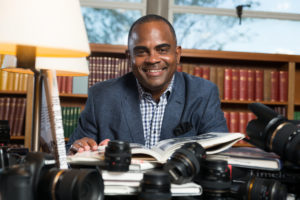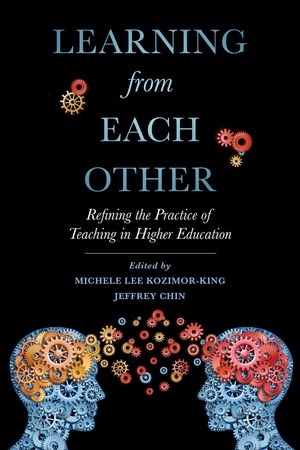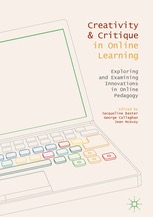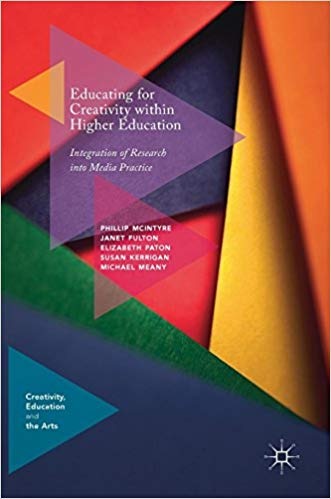creativity
Select an item by clicking its checkbox
Princeton Theological Seminary recently doubled-down on its commitment to residential theological education. As you can imagine, the transition online for an institution that has no online degree programming has been a shock to the system. However, last year, the seminary opened an Office of Digital Learning. With attentiveness to the ...
Teaching is an inherently creative act. We have been taught to teach as we were taught. I was taught by classic lecturers. If it wasn't the lecture it was the socratic method, seminar method or students present and lets see who can do the best. When I started teaching I ...
Date Reviewed: April 15, 2020
As faculty seek more effective learning and teaching practices, several disciplines have taken a “turn to reflective pedagogy” in recent years. Learning from Each Other: Refining the Practice of Teaching in Higher Education makes a substantive contribution to pedagogical practice in the discipline of sociology; this book is the result of workshops sponsored by the international honor society for the discipline. Contributors reflect a wide range of institutional types, teaching contexts, and research areas.
Following a brief introduction by the editors, the book is divided neatly into four parts: curricular innovations, classroom techniques, out-of-class situations, and assessment. Each chapter treats theory and strategy; this combination assures that topics are discussed with sufficient depth and adequate breadth of coverage across the discipline. References are included at the end of each chapter and the book closes with a useful index. Four of the twenty-one chapters in this book will be given attention here.
“Courting Controversy and Allowing for Awkward: Strategies for Teaching Difficult Topics,” by Mari Plikuhn, offers sound guidance applicable to any number of classroom discussions and contexts. The chapter addresses controversial content as well as classroom space; it includes helpful strategies for class structure and management. In “Becoming a Culturally Inclusive Educator,” Dena R. Samuels provides a guided sequence of practical steps for faculty engagement in this “transformative process” (203). The reader is encouraged to consider carefully the question of preparedness before working through the eight steps in this process. “The Value of Games and Simulations in the Social Sciences,” by Amanda M. Rosen, assesses the use of this active-learning strategy in a clear way. Rosen weighs barriers and incentives before addressing best practices. Finally, “Putting the Student at the Center: Contemplative Practices as Classroom Pedagogy,” by Tracey Wenger Sadd, supplies a succinct discussion of goals, outcomes, practices, and assessment of contemplative pedagogy. The chapter concludes with considerations and questions for determining the application of this pedagogy.
Instructors in Religious Studies and Theology are fortunate that these disciplines are strong in SOTL (scholarship of teaching and learning). These disciplines have a robust infrastructure for engaging in workshops, colloquies, and grant work to strengthen critical reflection on pedagogy. It is telling that instructors in these disciplines continue to produce and contribute highly impactful work on pedagogical research and practice that informs the national discourse. For this reason, there is much to be gained from this book. Discrete chapters may arouse interest in current trends, common questions, and shared efforts. Furthermore, attention to alternative perspectives on recurrent challenges and concerns distinct to a discipline can raise awareness. Finally, the recognition that higher education is growing ever more interdisciplinary makes this an opportune time to reflect on learning and teaching as a collaborative enterprise.
Date Reviewed: December 10, 2019
Online learning has come a long way in twenty years. Although distance education has been around in one form or another for a really long time, online education had fairly humble beginnings in California in the late 1990s. As noted in the foreword of Creativity and Critique in Online Learning, “At the end of the 1990s the internet was seen as an interesting application, but not necessarily relevant to all subjects or modes of teaching” (vii). The initial benefit of distance and online education was that it would connect learners together in a networked classroom that spanned further than four cinderblock walls. What initially started as a distance enterprise, where students would log in to a remote learning server and be funneled into a class with potentially dozens to hundreds of other faceless paying customers (and may or may not have received an actual education), the Learning Management System (LMS) has evolved into a “commonplace and essential piece of technology infrastructure in almost every university” (viii). Yet creativity does not come without critique, as is often the case when boundaries are stretched and broken. This volume provides a summary of the creative side of online learning as well as a critique of the overall process, at least within the purview of Open University’s experience as a leader in online learning, answering significant challenges and squashing anecdotal myths throughout.
The editors and contributors, all of whom are either faculty at Open University or products of one of Open University’s online programs, seek to rewrite the narrative regarding online education. Rather than asking “Can online study really replicate the challenges and occasional joy of learning in a face to face environment?” (2), these contributors shift the focus to answering questions such as “How can [online learning] help teach the ‘hard to reach’ and how can it provide learning for those who have failed in (or rejected) learning in a face to face context?” (2). Putting aside such arguments as online education being more cost-effective in a bloated yet dwindling brick-and-mortar learning environment and what tools and techniques work the best in an online context, the contributors pull directly from their experience and ground their findings in action research that seeks to add a cogent and coherent voice to the ever-widening field of online learning studies. Creativity and Critique in Online Learning presents real-world problems with and in online learning with real-world solutions from real-world practitioners, some of which worked and some which did not. Of particular note in this volume are the chapters on developing effective forums (chapter 3), engaging students in informal learning communities (chapter 5), addressing concerns with academic dishonesty (chapter 7), and developing appropriate yet effective teacher-learner relationships (chapter 11).
Overall, I found this volume helpful. As the director of a completely online graduate program in biblical studies and Christian leadership, I recognize the growing challenge of developing online learning experiences that are academically rigorous while also developing spaces for relational connection and personal growth. I was afraid this book would be another “do it our way” argument. However, the essays are more akin to the casual conversations we catch over coffee at a professional conference than the peer-reviewed “expert” keynote that we actually paid to hear.
Date Reviewed: December 10, 2019
As our students encounter work in what is more and more a gig economy, the authors of this book have been thinking about the implications of such employment for those entering the workforce and also for those who wish to pursue creative endeavors either as full-time or part-time work. The authors focus on creativity as a locus for student and worker resilience and adaptation to changes in global economics.
The first several chapters outline various theories of creativity. It is particularly useful that the authors elaborate on many varied theories of creativity within different academic disciplines and contexts. Chapter 1 includes thinking about creativity within a global context, and how different social, cultural, and political situations affect the development of ideas of what constitutes creativity, who is creative, and how they come to be creative. The authors consider the nature of creative development within both collectivist and individualist views of society. They also consider several religious contexts for the development of creativity, including thinking about humans as divine conduits, both as described in sacred texts (such as the story of Moses) and as the Muses working through artists.
One strength of the early chapters is seeing the deep theory of creativity in a number of fields. In chapters 3 and 4, the authors turn not just to describing theories, but to challenging them, saying that some might misidentify creativity. The authors probe the sociology and social systems that allow certain types of creativity to become dominant in various societies, and which types of creativity are recognized by their societies. The confluence approaches and systems model, which comprise the central chapters of the book, looks at a number of ways in which creativity can fit or allow a person to thrive within a system. The authors highlight various features such as intrinsic motivation, domain relevant skills (such as knowledge of field and necessary technical skills), and creativity relevant skills. An overwhelming strength of this book is how the reader can look through the authors’ lenses of multiple disciplines and access their background research, ideas, and the main voices in their fields for others to know, which helps readers understand how these ideas apply in various contexts.
In chapters 5 and 6, the authors turn from a descriptive project to a constructive one, considering how systems approaches can provide guidance for thinking about effective ways to develop creativity in higher education that will provide students and workers with the necessary tools to adapt to new work situations as our economies evolve. The authors then tease out implications and impacts of such a model and its adaptability to other contexts. All these confluence systems are deeply interactive, and recognize the context in which the person has lived and operates. It is here that the book best provides help to scholars and practitioners in theological and religious studies. While the book is written within the context of media studies, it is clear in the second half of the book where these systems approaches could apply to someone who wishes to either research or serve a religious community, and the authors have begun that work of thinking how this model can work in other contexts. In its last chapters, the book provides multiple ideas about how one’s context can positively shape the ability to develop and foster community.




